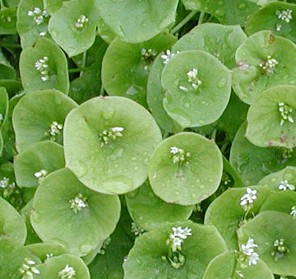 Miner’s lettuce is a rosette-forming annual native to Western North America from British Columbia to California and Mexico where it grows is moist disturbed areas. It is a member of the Montiaceae family and known by several names including winter purslane. The dark green leaves are united into one circular leaf and are carried on petioles up to eight inches long. The tiny pink or white flowers have five petals and appear from late winter into spring in clusters of five to forty. The leaves are often eaten in salad or cooked and retain their flavor even when the plant flowers, but become bitter in hot weather. Plants readily self seed and are often grown as a ground cover in partially shaded sites. The generic name, Claytonia, comes from the name of the eighteenth century English botanist, John Clayton, who came to America and became known as the greatest American botanist of his time. The specific name, perfoliata, refers to the characteristic of the leaf embracing the stem. The common name,Miner’s lettuce, refers to the fact that the California Gold Rush miners at the leaves as though they were lettuce.
Miner’s lettuce is a rosette-forming annual native to Western North America from British Columbia to California and Mexico where it grows is moist disturbed areas. It is a member of the Montiaceae family and known by several names including winter purslane. The dark green leaves are united into one circular leaf and are carried on petioles up to eight inches long. The tiny pink or white flowers have five petals and appear from late winter into spring in clusters of five to forty. The leaves are often eaten in salad or cooked and retain their flavor even when the plant flowers, but become bitter in hot weather. Plants readily self seed and are often grown as a ground cover in partially shaded sites. The generic name, Claytonia, comes from the name of the eighteenth century English botanist, John Clayton, who came to America and became known as the greatest American botanist of his time. The specific name, perfoliata, refers to the characteristic of the leaf embracing the stem. The common name,Miner’s lettuce, refers to the fact that the California Gold Rush miners at the leaves as though they were lettuce.
Type: Annual
Bloom: Small white five petaled flowers from late winter to spring
Size: 12” H x 12” W
Light: Dappled shade
Soil: Average (but toerates lean), moist
Hardiness: Zones 5-7
Care: Low maintenance
Pests and Diseases: Slugs
Propagation: Seed